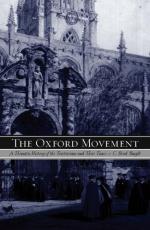All this time the four o’clock sermons at St. Mary’s were always going on. But, besides these, he anticipated a freedom—familiar now, but unknown then—of public lecturing. In Advent and after Easter a company, never very large, used to gather on a week-day afternoon in Adam de Brome’s Chapel—the old Chapel of “Our Lady of Littlemore”—to hear him lecture on some theological subject. It is a dark, dreary appendage to St. Mary’s on the north side, in which Adam de Brome, Edward II.’s almoner, and the founder of Oriel College, is supposed to lie, beneath an unshapely tomb, covered by a huge slab of Purbeck marble, from which the brass has been stripped. The place is called a chapel, but is more like a court or place of business, for which, indeed, it was used in the old days by one of the Faculties of the House of Convocation, which held its assemblies there. At the end is a high seat and desk for the person presiding, and an enclosure and a table for officials below him; and round the rest of the dingy walls run benches fixed to the wall, dingy as the walls themselves. But it also had another use. On occasions of a university sermon, a few minutes before it began, the Heads of Houses assembled, as they still assemble, in the chapel, ranging themselves on the benches round the walls. The Vice-Chancellor has his seat on one side, the preacher, with the two Proctors below him, sits opposite; and there all sit in their robes, more or less grand, according to the day, till the beadle comes to announce that it is time to form the procession into church. This desolate place Mr. Newman turned into his lecture-room; in it he delivered the lectures which afterwards became the volume on the Prophetical Character of the Church, or Romanism and Popular Protestantism; the lectures which formed the volume on Justification; those on Antichrist, and on Rationalism and the Canon of Scripture, which afterwards became Nos. 83 and 85 of the Tracts for the Times.[64] The force, the boldness, the freedom from the trammels of commonplace, the breadth of view and grasp of the subject which marked those lectures, may be seen in them still. But it is difficult to realise now the interest with which they were heard at the time by the first listeners to that clear and perfectly modulated voice, opening to them fresh and original ways of regarding questions which seemed worn out and exhausted. The volumes which grew out of the Adam de Brome lectures were some of the most characteristic portions of the theological literature of the early movement. They certainly greatly influenced the course of thought in it, and some of its most serious issues.




